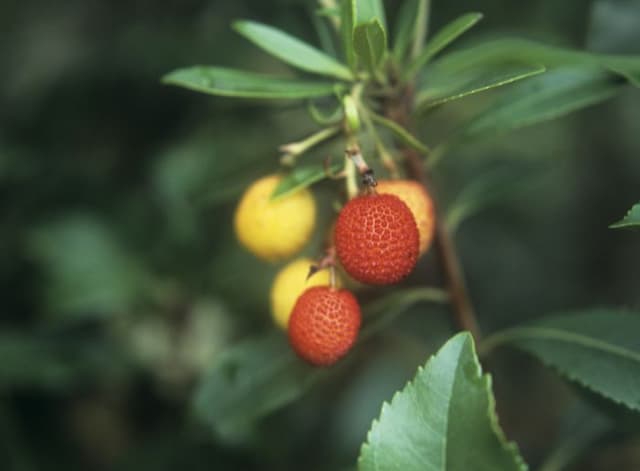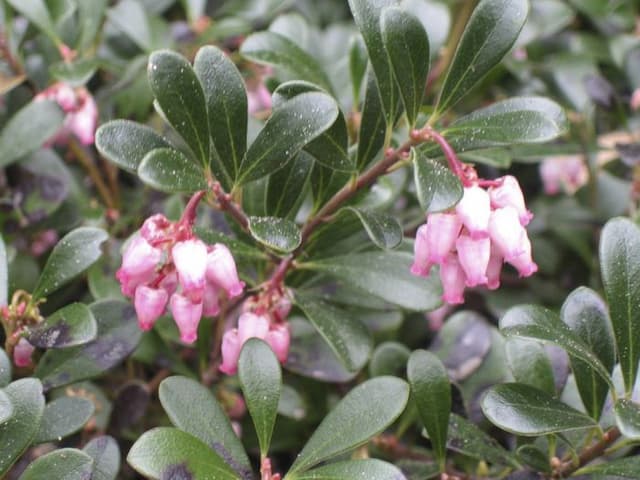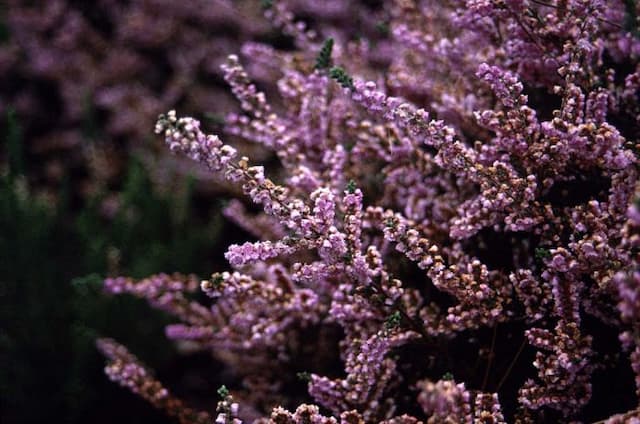Mountain Laurel Kalmia latifolia











ABOUT
The plant known commonly as mountain laurel is an evergreen shrub with a dense, rounded shape. Its leaves are leathery and dark green, with a glossy finish, showcasing an oval to elliptical shape. The foliage tends to cluster toward the ends of the branches, presenting a lush appearance. Mountain laurel is highly appreciated for its beautiful blooms. The flowers emerge in clusters called corymbs at the ends of the branches, typically during late spring to early summer. These blossoms are quite distinctive, often featuring a range of colors from white to pink to deep rose, sometimes with intricate purple markings inside. Each flower shows a unique, cup-like shape and the petals partially fuse together, creating a star-like pattern within the corolla. The buds before the flowers open are also quite ornamental, often appearing darker than the flower itself. The overall impression of the mountain laurel when in bloom is one of an abundant and luxurious display that stands out in woodland settings or ornamental gardens.
About this plant
 Names
NamesFamily
Ericaceae.
Synonyms
Mountain Laurel, Calico Bush, Spoonwood, Ivy Bush, Sheep Laurel, Lambkill, Clamoun, Kill-kid.
Common names
Kalmia latifolia f. myrtifolia, Kalmia latifolia var. myrtifolia, Kalmia latifolia var. polypetala, Kalmia latifolia var. polypetala.
 Toxicity
ToxicityTo humans
Mountain laurel is a plant known for its toxicity to humans. All parts of the mountain laurel plant are poisonous if ingested, containing grayanotoxins which can disrupt normal cell function. Consumption of the leaves, flowers, or nectar can lead to various symptoms including vomiting, stomach pain, dizziness, weakness, difficulty breathing, and may potentially induce a state of low blood pressure or even coma. Severe cases of mountain laurel poisoning can be life-threatening, and medical attention should be sought immediately if ingestion is suspected.
To pets
Mountain laurel is also toxic to pets, such as dogs and cats. Ingesting any part of the mountain laurel plant can lead to symptoms of poisoning in pets. These symptoms might include vomiting, diarrhea, excess salivation, weakness, and lethargy. More severe symptoms may manifest as low blood pressure, heart rhythm abnormalities, seizures, or even coma. In extreme cases, the toxicity can result in death. Because of its potential danger, it is important to prevent pets from accessing and ingesting this plant. Immediate veterinary care is required if a pet is suspected to have eaten any part of the mountain laurel.
 Characteristics
CharacteristicsLife cycle
Perennials
Foliage type
Evergreen
Color of leaves
Dark green
Flower color
Pink
Height
5-15 feet (1.5-4.6 meters)
Spread
5-15 feet (1.5-4.6 meters)
Plant type
Shrub
Hardiness zones
5-9
Native area
North America
Benefits
 General Benefits
General Benefits- Ornamental Value: Kalmia latifolia, commonly known as Mountain Laurel, is highly valued for its attractive, showy flowers that bloom in late spring to early summer, adding aesthetic appeal to gardens and landscapes.
- Habitat Support: The plant provides food for native pollinators, including bees and butterflies, during its blooming period.
- Erosion Control: With its evergreen foliage and shallow root system, Mountain Laurel can help control erosion on slopes or in areas with loose soil.
- Shade Tolerant: Mountain Laurel can thrive in partial shade, making it an ideal shrub for wooded areas or shaded gardens.
- Drought Resistance: Once established, the plant is relatively drought-tolerant, making it suitable for xeriscaping or low-water landscapes.
- Privacy Screening: When planted in groups or rows, Mountain Laurel can form dense thickets that offer privacy and noise reduction for property lines and garden spaces.
- Winter Interest: Its evergreen leaves provide year-round color and texture in the garden when many other plants are dormant.
- Wildlife Friendly: The thick foliage of Mountain Laurel offers shelter and nesting sites for birds and other small wildlife.
- Low Maintenance: The plant requires minimal upkeep once established, aside from occasional pruning to maintain shape and encourage growth.
 Medical Properties
Medical Properties- Analgesic - Kalmia latifolia has been used for pain relief.
- Antirheumatic - It has also been used to treat rheumatic pain.
- Anesthetic - There are reports of the plant being used for its numbing effects.
- Anti-inflammatory - The plant has been used for its potential to reduce inflammation.
- Cardiac depressant - Kalmia latifolia affects the heart rate and has been used with caution in traditional medicine.
 Air-purifying Qualities
Air-purifying QualitiesThis plant is not specifically known for air purifying qualities.
 Other Uses
Other Uses- Woodworking Material: The dense wood of Kalmia latifolia, commonly known as mountain laurel, is used for making small wooden objects such as bowls, spoons, and handles, prized for its fine grain and durability.
- Hedge Plant: Mountain laurel is often used in landscape design as a hedge plant because of its evergreen foliage, dense growth habit, and the attractive clusters of flowers it produces in the spring.
- Conservation Plantings: Used in reclamation projects and on disturbed lands, mountain laurel helps stabilize soil and prevent erosion due to its dense root system.
- Wildlife Habitat: Offering shelter and nesting sites, mountain laurel is valuable in wildlife gardens and natural areas, supporting birds and small mammals.
- Tannin Source: The leaves and twigs of mountain laurel can be used as a source of tannin for tanning hides in small-scale or traditional practices.
- Ink and Dye: Historically, some Native American tribes used parts of the plant to make dark colored dyes and inks for textiles and other materials.
- Cultural Symbolism: The mountain laurel is the state flower of Connecticut and Pennsylvania and is often used in decorative motifs and cultural symbols within these regions.
- Natural Fencing: Due to its dense growth, it can be planted as natural fencing along property boundaries as an alternative to manufactured fencing materials.
- Photography Subject: Mountain laurel's striking flowers and the overall plant structure are popular subjects for nature photographers, especially when in full bloom.
- Education and Research: The plant is used in educational settings and botanical studies for research on native plant species, pollination, and ecosystems.
Interesting Facts
 Feng Shui
Feng ShuiThe Mountain Laurel is not used in Feng Shui practice.
 Zodiac Sign Compitability
Zodiac Sign CompitabilityThe Mountain Laurel is not used in astrology practice.
 Plant Symbolism
Plant Symbolism- Caution: Kalmia latifolia, commonly known as Mountain Laurel, contains toxic substances, thus symbolizing the need for caution when proceeding in certain situations.
- Beauty and Ambivalence: With its stunning flowers, the Mountain Laurel represents the beauty of life. However, the plant’s toxicity adds an element of ambivalence to its symbolism.
- Protection: Native American tribes used Mountain Laurel in the creation of protective wreaths, suggesting the notion of spiritual protection and safeguarding against negative influences.
- Success and Achievement: In some traditions, Mountain Laurel blossoms are a symbol of accomplishment and triumph perhaps because the plant thrives in difficult conditions and manages to bloom beautifully regardless.
 Water
WaterMountain laurel should be watered deeply and thoroughly, ensuring the soil is moist but not waterlogged. Generally, watering once a week with about 1 to 1.5 gallons per plant is sufficient. However, frequency should be increased during dry spells to possibly twice a week. It's important not to overwater, as this can lead to root rot. During winter, watering can be reduced since the plant requires less moisture due to cooler temperatures and dormant growth.
 Light
LightMountain laurel thrives in part shade to full sun conditions. It performs best in a spot that receives morning sunlight and is protected from the intense afternoon sun, especially in hotter climates. An ideal location would provide dappled sunlight throughout the day, simulating the lighting conditions of its natural woodland habitat.
 Temperature
TemperatureMountain laurel can endure a temperature range of roughly -20°F to 100°F, but it flourishes in cooler climates between 60°F and 70°F. It is quite cold hardy and can survive winter temperatures that drop significantly below freezing. However, prolonged exposure to temperatures above 90°F may stress the plant.
 Pruning
PruningPrune mountain laurel to maintain shape and promote bushier growth. The best time for pruning is immediately after flowering finishes in early summer to avoid cutting off next year's buds. Light pruning every year or so helps to remove dead or broken branches and opens up the plant to better air circulation.
 Cleaning
CleaningNot needed
 Soil
SoilMountain laurel thrives in acidic, well-draining soil with a pH range of 4.5 to 5.5. A soil mix of peat moss, compost, and perlite can provide the ideal growing conditions for mountain laurel.
 Repotting
RepottingMountain laurel, also known as Kalmia latifolia, generally requires repotting every one to three years to refresh the soil and provide room for root growth.
 Humidity & Misting
Humidity & MistingMountain laurel prefers a humidity level that mimics its native woodland environment, which is moderately high; consistent moisture in the air without saturation is ideal.
 Suitable locations
Suitable locationsIndoor
Provide bright, indirect light and acidic soil.
Outdoor
Plant in partial shade, acidic soil, well-drained spot.
Hardiness zone
5-9 USDA
 Life cycle
Life cycleKalmia latifolia, commonly known as mountain laurel, begins its life as a seed, which germinates in moist, well-drained acidic soil conditions, usually in the spring or early summer. The seedling stage follows, characterized by the emergence of the plant's initial leaves and root system. The vegetative stage is marked by the growth of foliage and the development of a woody stem structure, enabling the plant to mature over several years. Once mature, mountain laurel enters the reproductive stage, producing clusters of pink or white flowers primarily in late spring to early summer, which are pollinated by insects like bees. Following pollination, the flowers develop into small brown capsules containing numerous seeds that, when mature, are released into the environment to begin a new life cycle. Mountain laurel is an evergreen shrub, so it retains its leaves year-round, continually growing and potentially flowering each year once maturity is reached.
 Propogation
PropogationPropogation time
Spring-Early Summer
Propogation: Mountain laurel (Kalmia latifolia) is most commonly propagated through semi-hardwood cuttings taken in late summer. To do this, select healthy, current year's growth and cut a 4 to 6 inch (about 10 to 15 cm) section just below a leaf node. Strip off the lower leaves, leaving a few at the top, and dip the cut end into a rooting hormone powder to encourage root development. Then, insert the cutting into a well-draining potting mix, ensuring the leaf nodes are buried where the removed leaves were. The pot should be placed in a warm environment with indirect light and kept moist, but not waterlogged. Rooting can take several weeks, after which the rooted cuttings can be gradually acclimated to outdoor conditions before transplanting.









